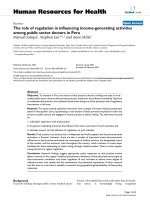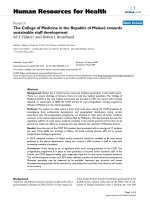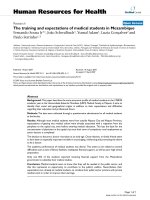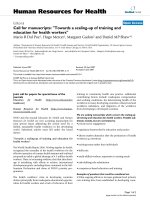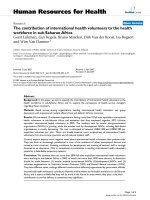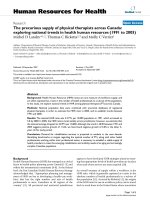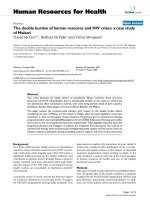báo cáo sinh học:" The health workforce crisis in Bangladesh: shortage, inappropriate skill-mix and inequitable distribution" potx
Bạn đang xem bản rút gọn của tài liệu. Xem và tải ngay bản đầy đủ của tài liệu tại đây (261.18 KB, 7 trang )
RESEARCH Open Access
The health workforce crisis in Bangladesh:
shortage, inappropriate skill-mix and
inequitable distribution
Syed Masud Ahmed
1*
, Md Awlad Hossain
1
, Ahmed Mushtaque RajaChowdhury
2
, Abbas Uddin Bhuiya
3
Abstract
Background: Bangladesh is identified as one of the countries with severe health worker sho rtages. However, there
is a lack of comprehensive data on human resources for health (HRH) in the formal and informal sectors in
Bangladesh. This data is essential for developing an HRH policy and plan to meet the changing health needs of
the population. This paper attempts to fill in this knowledge gap by using data from a nationally representative
sample survey con ducted in 2007.
Methods: The study population in this survey comprised all types of currently active health care providers (HCPs)
in the formal and informal sector s. The survey used 60 unions/wards from both rural and urban areas (with a
comparable average population of approximately 25 000) which were proportionally allocated based on a
‘Probability Proportion to Size’ sampling technique for the six divisions and distribution areas. A simple free listing
was done to make an inventory of the practicing HCPs in each of the sampled areas and cross-checking with
community was done for confirmation and to avoid duplication. This exercise yielded the required list of different
HCPs by union/ward.
Results: HCP density was measured per 10 000 population. There were approximately five physicians and two
nurses per 10 000, the ratio of nurse to physician being only 0.4. Substantial variation among different divisions
was found, with gross imbalance in distribution favouring the urban areas. There were around 12 unqualified
village doctors and 11 salespeople at drug retail outlets per 10 000, the latter being uniformly spread across the
country. Also, there were twice as many community health workers (CHWs) from the non-governmental sector
than the government sector and an overw helming number of traditional birth attendants. The village doctors
(predominantly males) and the CHWs (predominantly females) were mainly concentrated in the rural areas, while
the paraprofessionals were concentrated in the urban areas. Other data revealed the number of faith/traditional
healers, homeopaths (qualified and non-qualified) and basic care providers.
Conclusions: Bangladesh is suffering from a severe HRH crisis–in terms of a shortage of qualified providers, an
inappropriate skills-mix and inequity in distribution–which requires immediate attention from policy makers.
Background
Human resource for health (HRH) is the critical limiting
factor determining the health of the population besides
socioeconomic, behavioural and environmental factors
[1,2]. Globally, there is a close correlation between the
concentration of qualified health workers (doctors,
nurses, dentists and midwives together) and key health
outcomes such as immunization coverage, primary
health care outreach, and infant, under-5 and maternal
survival. This is because “in health systems, workers
function as gatekeepers and navigators for the effective,
or wasteful application of all other resources such as
drugs, vaccines and supplies” [3]. The shortage of quali-
fied health workers, especially in low-income countries,
has drawn attention in recent times, as it seriously
threatens the attainment of the millennium development
goals (MDGs) [4,5].
* Correspondence:
1
Research and Evaluation Division, BRAC, 75 Mohakhali, Dhaka-1212,
Bangladesh
Full list of author information is available at the end of the article
Ahmed et al. Human Resources for Health 2011, 9:3
/>© 2011 Ahmed e t al; licensee BioMed Central Ltd. This is an Open Access article d istribute d under the terms of the Creative Co mmons
Attribution License (http://creative commons.org/licenses/by/2.0 ), which permits unrestricted use, di stribution, and reproduction in
any medium, provided the origina l work is properly cited.
The c ountries of WHO’ s South-East Asia Region also
face several common health workforce relate d problems
and issues concerning shortage, skill-mix, migration,
work environment, knowledge-base and other areas amply
articulated in the ‘Dhaka Declaration’ [6]. Bangladesh is
no exception in this regard and it is one of the coun-
tries with ‘severe shortages’ of health workers [3].
Given the shortage of supply of qualified health care
providers in Bangladesh, patients, especially the poor
and the disadvantaged, mostly seek health care from
the nonqualified providers in the informal sector [7,8].
On the demand side, due to lack of health awa reness,
the overall health service consumption (from any
source) in Banglad esh is low compared to other devel-
oping countries, as is level of need [9,10]. Evidence
shows that overall levels of per capita consumption of
essential service package (ESP) would have to increase
by 40% i n order to achieve the higher average level of
other developing countries [11].
To develop an effective, efficient and equitable health
system for meeting t he goal of improved and equitable
population health, human resources for health (HRH)
should be appropriate in relation to number, skill-mix,
and distribution with optimum competency and motiva-
tion. There is a lack of comprehensive, nationally repre-
sentative data on HRH in the formal and informal sectors
in Ba ngladesh. This is essential for developing an HRH
policy and plan and its implementation to meet the chan-
ging health needs of the population. A population-based,
nationally representative survey covering all types of health
care providers in the formal and informal sectors was done
in 2007 by Bangladesh Health Watch (BHW) to fill in this
knowledge gap [12]. BHW is a civil society initiativ e “to
regularly and systematically measure and monitor the
country’s progress and performance in health”. This paper
presents data from this survey and discusses its implica-
tions for HRH problems in Bangladesh.
Materials and methods
Study population and sampling
The study population in this survey comprised of all types
of health care providers (HCPs)–allopathic and non-
allopathic, trained and untrained, and in public or private
sector–who were currently active in pro viding healthcare
servic es to the community in the study areas. The survey
used 60 primary sampling units (PSUs, a cluster of around
200 households) drawn randomly from the nationally
representative 1000 PSUs that are used by the Bangladesh
Bureau of Statistics (BBS) for its Sample Vital Registration
System, yielding estimates up to the lev el of district [13].
ThenumberofsamplePSUs(n=60)wasconveniently
determined given constraints in time and resources. From
the total number of PSUs in each of the division, the
required number of sample PSUs was taken randomly,
following a PPS (Probability Proportion to Size) sampling
technique. Table 1 shows this proportional allocation of
the sample PSUs by division. Thus, the sampling provided
representative estimates of the density of health care pro-
viders for the country as a whole, for the urban and the
rural areas separately, and for each of the si x admini stra-
tive divisions (note that the study was done prior to the
2010 creation of a seventh Bangladesh i division). Since a
PSU may not be large enough to have sufficient HCPs in
termsofnumberaswellasdiversity,weusedtheUnion
and the Ward (lowest administrative units having compar-
able population size of around 25 000) containing the
selected PSU as t he sampling unit for the rural a nd the
urban areas respectively. Data collection was done during
July-September 2007.
Inventory of health care providers
All the villages, markets and health facilities/centres under
each PSU (Union/Ward) were visited by the field enumera-
tors (social science gradua tes) w ho were recruited and
trained by the research team. They started by identifying
the initial batch of k ey informants t hrough informal d iscus-
sion (asking questions such as “Who in your locality can
give valid information about the number and types of the
HCPs?”) with community members in the markets and vil-
lages. Further key informants were then identified from this
information using a ‘snowball’ technique. The key infor-
mants were then asked to list all the practicing HCPs they
knew in the locality (free listing), a nd an inventory of practi-
cing HCPs was made for each of the geographical areas vis-
ited. The key-informants sometimes provided information
about the HCPs’ names in different ways (e.g., nick name,
family name, title, etc.). These were cross-checked with
other key informants and village people for proper identifi-
cation, and to avoid duplication and omission, especially in
the case of the informal sector providers. Also, they visited
the residences of the HCPs for on-the-spot co nfirmation
whenever confusion arose. It was relatively easy to get the
list of working HCPs from the administrative authorities in
different public and private sector healthcare facilities. The
enumerators also frequently checked authenticity of infor-
mation with the HCPs whenever feasible. During this pro-
cess, they explained the purpose of the inventory and
sought their cooperation for improving the validity of the
data. Finally, this exercise yielded a list of different HCPs by
Union/Ward (PSU).
Categorization of the informal health care providers
The informal health care providers (not registered with
any government regulatory body) were categorized into
the following groups:
1) S emi-qualified allopathic providers: include provi-
ders who h ave received training of varying duration
Ahmed et al. Human Resources for Health 2011, 9:3
/>Page 2 of 7
from a formal institution in the public or private
sector such as the non-profit NGOs.
a. Para-professionals: comprised of the medical
assistants who completed a three-year medical
assistant training programme from a public insti-
tution, mid-wives (family welfare visitor (FWV))
with 18 months training in midwifery and clini-
cal contraception management from public/
private institutions, and lab-technicians/
physiotherapists
b. Community health workers (CHWs) from
both public and non-governmental organisation
(NGO) sectors. The CHWs in the NGO sector
outnumberthoseinthepublicsectorbyaratio
of 2:1 [12]. CHWs have variable lengths of basic
preventive and curative health care training,
from various health care providing NGOs mainly,
but also from the public sector.
2) Unqualified allopathic providers: included in this
category are village doctors and drug store sales peo-
ple/drug vendors.
a. The village doctors (also known as rural medi-
cal practitioner, RMP) mostly received short
training (from a few weeks to a few months) on
some common illnesses/conditions, from semi-
formal private institutions which are unregistered
and unregulated and d o not follow a standard
curriculum. A negligible proportion of them
received twelve months training from a short-
lived government sponsored programme (the
‘Palli Chikitsok’ (PC) training programme, which
followed the China’s model of barefoot doctors)
in the ‘80s.
b. Drug store salespeople: most of have had no
training in dispensing, not to speak of training in
diagnosis and treatment.
3) Traditional healers: ‘Kabiraj’, whose practice is
based o n diet, herbs, and exercise. They are mostly
self-trained, b ut some may have training from gov-
ernment or private colleges of Ayurvedic medicine.
Some of them combine ayurvedic, unani (traditional
muslim medicine originating from Greec e) and allo-
pathic medicine to provide ‘tot ka’ treatment. This
category also includes non-secular faith healers.
4) Traditional birth attendants: includes both trained
and non-trained providers who deliver home-based
services only.
5) Homeopaths: mostly self-educated, but some pos-
sess a recognized qualification from government or
private homeopathic colleges.
The survey
The s tudy passed the ethical review board of the James
P. Grant School of Public Hea lth, BRAC University for
ethical approval. Informed consent was taken before
interviewing. All enumerators hired for the survey
underwent a five-day training which consisted of didac-
tic lectures followed by practice sessions outside the
study areas. The day-to-day field activities of the teams
were overseen by a field researcher based in the Upazila
(sub-district) field office. The whole survey activity was
supervised and managed by the authors who made fr e-
quent field visits and provided assistance and guidance
when needed. SPSS PC+ ver.12 was used for data
analysis.
Results
Table 2 presents the density (per 10 000 pop ulation) of
doctors, nurses and dentists by region (division), geogra-
phical location (rural/urban) and sex (male/female).
There were around five physicians and tw o nurses per
Table 1 Number of sample Primary Service Units (PSUs) by division and rural/urban areas according to PPS
(Probability Proportion to Size)
Division Total PSUs enumerated by Bangladesh
Bureau of Statistics for Sample
Registration Survey
Number of sample PSUs taken
All Urban All Rural Urban
Barisal 79 11 4.7 ≈ 54 1
Chittagong 172 41 10.3 ≈ 10 8 2
Dhaka 307 105 18.4 ≈ 18 12 6
Khulna 125 25 7.5 ≈ 86 2
Rajshahi 263 39 15.8 ≈ 16 14 2
Sylhet 55 7 3.3 ≈ 32 1
Rural 774 — 46.5 ≈ 46 ——
Urban 225 — 13.5 ≈ 14 ——
Total 1000 60 46 14
Note: Urban area included the statistical metropolitan area (SMA), municipality area and other urban areas (e.g. ‘than a sadar’ area which has the quality of
municipality).
Ahmed et al. Human Resources for Health 2011, 9:3
/>Page 3 of 7
10 000 popul ation, the ratio of nurse to phys ician being
0.4 only (i.e. 2.5 times more doctor than nurses). The
ratio was equa l in Khu lna (1.4), b ut very low in Sylhet
(0.1) and low in Dhaka (0.2). Substantial variation in the
density of physicians and nurses among different divi-
sions was found, Dhak a having the highest density of
physicians followed by Chittagong, while in the case of
nurses, this trend was reversed. Gr oss imbalance in den-
sity favouring urban a reas was also observed, especially
for the physicians. Similarly, there was al so gross imbal-
ance in sex ratio, favouring males in the case of physi-
cians (four males to one female), and females in the
case of nurses (nine females to one male ). Together,
there were 7.7 formally qualified registered health care
professionals per 10 000 population.
The density of the other categories of allopathic health
care providers (semi-qualified/unqualified) is presented
in Table 3. There were around 12 village doctors and 11
sales people at drug retail outlets (p roviding diagnosis
and treatment) per 10 000 population. Thus, there were
about 2.5 times more village doctor s and 2 times more
drug store salespeople than were physicians who provide
treatment/curative services to the population. There was
not much variation in the density of the drug store
salespeople between urban and rural areas (13 and 11
per 10 000 population) indicating their uniform spread
across the country. However, their density was lowest in
Barisal and Sylhet divis ions compared to others. Also,
there were twice as many CHWs from the NGO sector
per 10 000 population (6) than from the government
sector (3) and an overwhelming number of traditional
birth attendants (TBAs) and/or trained traditional birth
attendants (TTBAs). The TBAs/TTBAs were involved in
providing delivery-related services at home only. The
village doctors and the CHWs were mainly concentrated
in the rural areas while the paraprofessionals were con-
centrated in the urban areas. Dhaka had the lowest num-
ber of village doctors and Sylhet the lowest number of
CHWs than other divisions. The village doctors and the
drugstore salespeople were predominantly male com-
pared to the CHWs who were predominantly female.
Finally, Table 4 presents the density of non-allop athic
health care providers such as traditional healers and
homeopaths. There were large numbers of faith healers
as well as Kabiraj and other traditional healers (31 and
33 per 10 000 population respectively), who were pro-
viding health care services as reveal ed from this inven-
tory. This was supplemented by 3 qualified and 2.5
unqualified homeopaths per 10 000 population in the
country. The traditional practitioners were mostly male,
concentrat ed in the rural areas of Chittago ng, Rajshahi
and Khulna divisions. On the other hand, the homeo-
paths were concentrated in the urban areas, mainly in
the Khulna and Rajshahi divisions. Interes tingly, about
one provider (per 10,000 population) was engaged in
delivering health related services such as circumcision,
cleaning ears and extracting painful tooth at a nominal
cost, mainly to the poorer section of the population.
Discussion
Bangladesh is declared by WHO as one of the 58 crisis
countries facing an acute HRH crisis [3]. However, this
is given little importance in national health activities [
and there exists a dearth of information on these aspects
at na ti onal level [14]. The Health Care Provider Survey
2007 [12] attempted to fill in this critical knowledge gap
and help g uide in formulating appropriate policies to
improve the health system’s ability to reach the people
with an ac ceptable quality of services [15], and rational
skill-mix in foreseeable future.
The survey is unique in that it had included all types
of healthcare providers in the formal and informal sec-
torsandthuspresentsacomprehensivepictureofthe
healthcare s cenario prevailing in the country. It used a
nationally representative sample frame, and a PPS sam-
pling strategy t o take care of the size of the divisions
and the rural/urban divides. However, due to constraint
in time and resources, the number of sample clusters
had to be limited to 60, a multiple of the six administra-
tive divisions in the country.
Shortage
Findings revealed that the density (per 10 000 popula-
tion) of physicians and nurses has increased over the
last decade (from 1.9 physicians and 1.1 nurses in 1998
to 5.4 physicians and 2.1 nurses in 2007) [9] though it
remains much lower than the estimated average for low
income countries in 1998 [16]. The density of dentists
Table 2 Distribution of doctors, nurses and dentists per
10 000 people in various Bangladeshi divisions
Doctors Nurses Dentists All Nurse per
Doctor ratio
Division
Barisal 1.7 0.9 0.3 3.08 0.5
Chittagong 4.8 3.6 0.3 8.8 0.7
Dhaka 10.8 2.8 0.5 14.2 0.2
Khulna 1.3 1.9 0.05 3.3 1.4
Rajshahi 2.1 1.1 0.0 3.2 0.5
Sylhet 2.2 0.4 0.0 3.2 0.1
Location
Rural 1.1 0.8 0.08 2.1 0.7
Urban 18.2 5.8 0.8 24.9 0.3
Sex
Male 4.5 0.2 0.2 5.0 0.05
Female 0.8 1.8 0.03 2.7 2.1
All 5.4 2.1 0.3 7.7 0.4
Ahmed et al. Human Resources for Health 2011, 9:3
/>Page 4 of 7
has also increased, but remains at a very low level (from
0.01 in 1998 to 0.3 in 2007). However, the density of
formally qualified health care professionals (HCPs) (doc-
tors, nurses and dentists) (7.7) is lower than other south
Asian countries (e.g. 21.9 in Sri Lanka, 14.6 in India,
and 12 .5 in Pakistan) and falls far short of the estimate
projected by WHO (23.0) which would be needed for
achieving the MDG targets [3]. During this time, the
density (per 10 000) of traditional birth attendants
declined(from55in1981to33in2007),presumably
due to the stoppage of TBA training by the Government
of Bangladesh in 1998 [17].
On the other hand, the increase in the number of
unqualified a llopathic providers during the past decade
Table 3 Distribution of semi-qualified and unqualified allopathic providers per 10 000 populations, various
Bangladeshi divisions
Semi-qualified allopathic providers* Unqualified allopathic providers
Paraprofes-
sionals
Community Health Workers
Govt. Non-Govt.(including
traditional birth
attendants)
All Village doctors** (rural medical
practitioners/’Palli Chikitsok’ village
doctors)
Dug store
salespeople, drug
vendors
All
Division
Barisal 0.7 4.5 37.9 42.4 15.5 6.5 22.1
Chittagong 1.6 4.6 50.9 55.5 17.1 8.7 25.8
Dhaka 0.8 2.6 26.6 29.2 9.8 11.9 21.8
Khulna 0.6 3.0 46.3 49.9 11.3 12.3 23.6
Rajshahi 1.3 3.0 48.3 51.4 13.5 13.4 26.9
Sylhet 0.6 3.8 41.4 45.3 12.7 6.3 19.0
Location
Rural 0.8 3.6 49.5 14.1 13.8 10.8 24.6
Urban 1.6 2.0 10.1 12.1 8.8 13.2 22.1
Sex
Male 0.3 1.2 0.2 1.4 12.0 11.0 23.0
Female 0.7 2.0 39.4 41.4 0.4 0.4 0.9
All 1.0 3.2 39.7 42.9 12.5 11.4 23.9
*received varying length of training from formal institutions, GO or NGO.
**the Palli Chikitsok village doctors are included in this group because they are few in number, were trained on or before 1982 without any further re-training,
and no different from the rural medical practitioners in practice.
Table 4 Distribution of traditional healers, homeopaths and others per 10,000 populations, various Bangladeshi
divisions
Traditional healers Homeopaths Others*
Kabiraj,
Totka
Faith
healers
All Qualified Unqualified All
Division
Barisal 12.8 17.7 30.5 1.0 2.3 3.3 1.7
Chittagong 49.3 40.6 89.9 3.0 1.6 4.7 2.2
Dhaka 29.6 20.3 49.8 3.6 1.2 4.7 2.6
Khulna 38.2 28.0 66.2 3.9 4.7 8.6 0.9
Rajshahi 35.7 45.8 81.6 3.6 3.9 7.5 1.1
Sylhet 14.9 38.1 53.1 3.8 2.2 6.1 0.0
Location
Rural 42.1 40.5 82.6 2.5 2.9 5.5 1.05
Urban 4.4 4.2 8.6 6.1 0.9 7.0 4.02
Sex
Male 23.4 22.2 45.6 3.2 2.3 5.5 1.4
Female 9.3 9.3 18.6 0.3 0.1 0.4 0.3
All 32.7 31.5 64.2 3.4 2.5 5.9 1.7
*Circumcision practitioners, ear cleaners, tooth extractors, etc.
Ahmed et al. Human Resources for Health 2011, 9:3
/>Page 5 of 7
has been phenomenal compared to the qualified or
semi-qualified allopathic providers. For example, the
number of unqualified allopathic providers (village doc-
tors and drug store salespeople) (24 per 10 000) has
increased to about twice that estimated by the research
agency, ‘Org-Marg Quest’ at the h igher range (14.5 per
10 000) [18]. Similarly, the densi ty of tradit ional healers
(64 per 10 000) in this study has been found to be mor e
than 2.5 t imes than the density estimated by Ali at the
higher range (24 per 10 000) [19].
Inappropriate skill-mix
The current nurse-doctor ratio of 0.4 (i.e. 2.5 times
more doctors than nurses) is far short of the interna-
tional standard of around three nurses per doctor. Inter-
estingly, the equal nurse-doctor ratio in Khulna and
very low nurse-doctor ratio in Sylhet is also associated
with better health indicators in Khulna and worse health
indicators in Sylhet. The importance of the nursing
population for healthier communities (compared to indi-
vidual outcomes in case of doctors) cannot be overem-
phasized [20]. There is also a gross imbalance in the
doctor-technologist ratio as well, the ideal being five
technologists for one docto r. An estimate of shortage
based on th e doctor-population ratio currently prevalent
in low-income countries revealed a shortage of over
60 000 doctors, 280 000 nurses and 483 000 health
technologists in Bangladesh [12].
Inequitable distribution
It is interesting to note that the overwhelming urban
bias of the distribution of th e formally qualified HCPs,
noted a decade ago, has remai ned a pe rsistent phenom-
enon [16]. Also, these providers are inequitably concen-
trated in the Dhaka and Chittagong regions. The CHWs
from the non-government sector and the village doctors
are mainly concentrated in the rural areas. Interesti ngly,
the salespeople at drug retail outlets (shops) are evenly
distributed between the rural and urban are as, showing
their unhindered expans ion across the country. Accord-
ing to an est imate, there are about 80 000 unlic ensed
drugstores in the country [21]. This mushrooming of
unregulated drug shops is facilitated by easy availability
of essential d rugs at low price following the National
Drug Policy of 1982 [22] and also the availability of pre-
scription drugs over-the-counter.
Addressing shortage and skill-mix problems:
what can be done?
The large-scale shortage of qualified healthcare provi-
ders, coupled with an inappropriate skill-mix (more doc-
tors than nurses and technologists) needs urgent
attention to cater to the healthcare needs of the pop ula-
tion. While in the short-term it is nearly impossible to
produce the huge numbers of estimated healthcare pro-
viders by the public and private sectors combined [12],
the disease profile in the countr y does not always war-
rant provision of services by qualified health profes-
sionals. According to the Bangladesh Bureau of
Statistics [23], the most co mmon illnesses (both sexes)
in order of frequency are: fever (55%), pain (10%), diar-
rhoea(6%)anddysentery(4%).Theabovepatternof
disease burden, at least in the primary care level, can be
handled by the paraprofessionals (medical assistants,
family welfare visitors (FWVs)), including CHWs, with
the establishment of a functional referral system to a
higher level of facilities [24,25].
The CHWs have been increasing in size since the nine-
ties, with the expansion of the government and NGO
health network in the country. They have been found to
be cost-effective [26,27] and useful in the management of
childhood pneumonia [28], acute respiratory infections of
children [29], screening childhood hearing impairment
[30], and DOTS treatment of tuberculosis [31] in rural
Bangladesh. Training may also be provided to improve
the competency of the vast army of unqualified providers
(especially village doctors) in rational and harmless
healthcare provision [32]. Any concern that upgrading
their diagnostic and curative skills may lead to abuse and
malpractice may be con tained by managerial and regula-
tory interventions by the public sector [33].
Conclusions
Bangladesh is suffering from a severe HRH crisis in
terms of a shortage of qualified providers (when mea-
sured against the WHO estimate for achieving MDG
targets), i nappropriate skills-mix and inequity in distri-
bution. This desperate situation demands immediate
attention from policy makers. Reducing the ‘income-ero-
sion’ effect of illness through a pro-poor health system
is urgently needed in Bangladesh, a country besieged
with large out-of-pocket payments for healthcare.
Acknowledgements
The authors wish to acknowledge gratefully the time and experiences
shared by the respondents in this study. The study was funded by the
Swedish International Development Agency (SIDA). Thanks are also due to
the Bangladesh Health Watch, a civil society initiative ‘to regularly and
systematically measure and monitor the country’s progress and performance
in health’, who sponsored the larger Bangladesh Health Care Provider Survey
2007.
Author details
1
Research and Evaluation Division, BRAC, 75 Mohakhali, Dhaka-1212,
Bangladesh.
2
James P Grant School of Public Health, BRAC University, 66
Mohakhali, Dhaka-1212, Bangladesh.
3
ICDDRB, Mohakhali, Dhaka-1212,
Bangladesh.
Authors’ contributions
SMA, AMR, and AB conceptualized and designed the study; MAH helped in
sampling and fielding the study. SMA and MAH analysed and interpreted
Ahmed et al. Human Resources for Health 2011, 9:3
/>Page 6 of 7
the data; AMR and AB also helped in its interpretation. SMA drafted the
manuscript and MAH, AMR and AB put critical inputs in improving the draft.
SMA revised and prepared the final draft. All authors read the final draft and
approved it for submission.
Competing interests
We declare that we have no competing interests in conducting the research
and writing the manuscript.
Received: 11 February 2010 Accepted: 22 January 2011
Published: 22 January 2011
References
1. Anand S, Barnighausen T: Health workers and vaccination coverage in
developing countries: an econometric analysis. Lancet 2007,
369:1277-1285.
2. JLI (Joint Learning Initiative): Human Resources for Health: Overcoming
the crisis. Boston: Harvard University Press; 2004.
3. World Health Organization (WHO): The World Health Report 2006 -
Working together for health. Geneva: World Health Organization; 2006.
4. Task Force on Health Systems Research: Informed choices for attaining
the Millennium Development Goals: towards an international
cooperative agenda for health-system research. Lancet 2004,
364:997-1003.
5. GHW (Global Health Watch): Global Health Watch 2005-2006: An
alternative world health report. London and New York: Zed Books; 2005.
6. Dhaka Declaration: Dhaka Declaration on Strengthening Health
workforce in the Countries of South-East Asia Region. [ro.
who.int/LinkFiles/Health_Ministers_Meeting_2006_HMM24_5_Dha
ka_Decleration_Final.pdf].
7. Ahmed SM: Exploring health-seeking behaviour of disadvantaged
populations in rural Bangladesh. PhD Thesis Karolinska Institutet University,
Deptt. Of Public Health Sciences; 2005 [ />435-X/].
8. Cockcroft A, Anderson N, Milne D, Hossain MZ, Karim E: What did the
public think of the health services reform in Bangladesh? Three national
community-based surveys 1999-2003. Health Res Policy Systems 2007, 5:1
[ />9. World Bank: Private sector assessment for Health, Nutrition and
Population (HNP) in Bangladesh. Report No. 27005-BD. Washington DC:
World Bank; 2003 [ />%20and%20Reference/20206318/Bangladesh_PSA_for_HNP-Full%20report.
pdf].
10. Mercer AJ, Hossain S, Khatun J, Kabir H, Saha N, Uddin J, Hassan Y:
Screening for service needs in Primary Health Care clinics: an evaluation
in Bangladesh. J Health Popul Developing Countries 2005 [dc.
unc.edu].
11. Ensor T, Dave-Sen P, Ali L, Hossain A, Begum SA, Moral H: Do essential
service packages benefit the poor? Preliminary evidence from
Bangladesh. Health Policy Plan 2002, 17:247-256.
12. Bangladesh Health Watch: Health Workforce in Bangladesh: Who
constitutes the healthcare system? The state of health in Bangladesh
2007. Dhaka: James P Grant School of Public Health, BRAC University; 2008.
13. BBS (Bangladesh Bureau of Statistics): Report of Sample Registration
System 2002. Dhaka: BBS; 2004.
14. Independent Review Team: Bangladesh Health, Nutrition and Population
Sector Programme (HNPSP) Mid-term Review Volume II: Technical
Reports relating to Service Delivery, Systems and Governance. Dhaka
2008 [ />15. Gwatkin DR, Bhuiya A, Victora CG: Making health systems more equitable.
Lancet 2004, 364:1273-1280.
16. Hossain B, Begum K: Survey of the existing health workforce of Ministry
of Health, Bangladesh. Hum Resour Dev J 1998, 2:109-116.
17. World Health Organization (WHO): Skilled birth attendance: review of
evidences in Bangladesh. Dhaka: World Health Organization; 2004
[ />18. ORG-Marg Quest Ltd: Survey on village doctors practicing in
Brahmanpara. Report for British council and NICARE. Dhaka
2000.
19. Ali QL: Calculation of total unit cost for diarrhoeal management at
district hospital and thana health complex, Dhaka. Dhaka: Health
Economics Unit, Ministry of Health and Family Welfare, Government of
Bangladesh; 2001.
20. Bigbee JL: The relationships between nurse and physician-to-population
ratios and state health rankings. Public Health Nurs 2008, 25(3):244-252.
21. Anonymous: Fake drugs flood Bangladesh. Pharmacochronicles 2004
[ />22. Islam N: Bangladesh national drug policy: an example for the third
world? Trop Doct 1999, 29:78-80.
23. BBS (Bangladesh Bureau of Statistics): Statistical Pocket Book 2007. Dhaka:
BBS, Planning Division, Ministry of Planning, GoB; 2008.
24. Kruk ME, Prescott MR, de Pinho H, Galea S: Are doctors and nurses
associated with coverage of essential health services in developing
countries? A cross-sectional study. Human Resources for Health 2009, 7:27.
25. Standing H, Chowdhury AMR: Producing effective knowledge agents in a
pluralistic environment: What future for community health workers? Soc
Sci Med 2008, 66(10):2096-2107.
26. Islam MA, Wakai S, Ishikawa N, Chowdhury AM, Vaughn JP: Cost-
effectiveness of community health workers in tuberculosis control in
Bangladesh. Bull World Health Organ 2002, 80:445-450.
27. Khan MM, Saha KK, Ahmed S: Adopting integrated management of
childhood illness module at local level in Bangladesh: implications for
recurrent costs. J Health Popul Nutr 2002, 20:42-50.
28. Winch PJ, Gilroy C, Starbuck ES, Young MW, Walker LD, Black RE:
Intervention models for the management of children with signs of
pneumonia or malaria by community health workers. Health Policy Plan
2005, 20:199-212.
29. Hadi A: Management of acute respiratory infections by community
health volunteers: experience of Bangladesh Rural Advancement
Committee (BRAC). Bull World Health Organ 2003, 81:183-9.
30. Berg AL, Papri H, Ferdous S, Khan NZ, Durkin MS: Screening methods for
childhood hearing impairment in rural Bangladesh. Int J Pediatric
Otorhinolaryngology 2005, 70:107-14.
31. Chowdhury AMR, Chowdhury S, Islam MN, Islam A, Vaughan JP: Control of
tuberculosis by community health workers in Bangladesh. Lancet 1997,
350:169-72.
32. Ahmed SM, Hossain MA, Chowdhury MR: Informal sector providers in
Bangladesh: how equipped are they to provide rational health care?
Health Policy Plan 2009, 24:467-478.
33. Kamat VR, Nichter M: Pharmacies, self-medication and pharmaceutical
marketing in Bombay, India. Soc Sci Med
1998, 47:779-794.
doi:10.1186/1478-4491-9-3
Cite this article as: Ahmed et al.: The health workforce crisis in
Bangladesh: shortage, inappropriate skill-mix and
inequitable distribution. Human Resources for Health 2011 9:3.
Submit your next manuscript to BioMed Central
and take full advantage of:
• Convenient online submission
• Thorough peer review
• No space constraints or color figure charges
• Immediate publication on acceptance
• Inclusion in PubMed, CAS, Scopus and Google Scholar
• Research which is freely available for redistribution
Submit your manuscript at
www.biomedcentral.com/submit
Ahmed et al. Human Resources for Health 2011, 9:3
/>Page 7 of 7
